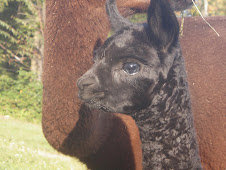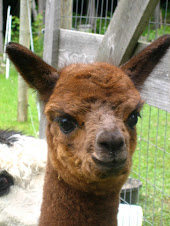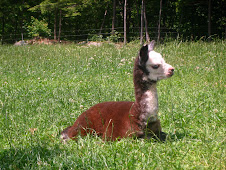Monday, November 8, 2010
Feeding an Orphaned Alpaca Cria
It is unfortunate, but does happen sometimes, when a mother either dies or cannot nurse her cria. The good news is that there are options to keep your cria alive and well.
One of the four major causes of death for crias is starvation. For the well-being of the cria you need to get him to learn to bottle feed while monitoring him.
Bottle Feeding
• How Much - A cria should consume 15% of body weight to grow. Spread feedings out over 7 feedings a day for a newborn and working down to 4 a day for a one month old cria. You can do one at 10-11pm and then not again til 6-7am and still get in many day feedings.
• What - There are many different options of what to feed the alpaca cria. Here is what we chose to feed:
2 T probiotic yogurt (vanilla or plain)
3-4 oz half and half
5 oz raw cow milk (or goat or whole pasturized is OK)
• Bottle - a human baby bottle is fine. Cut an "x" in the nipple to make it flow better.
• Positioning - Make sure the crias head is tilted upward like it would be nursing from his mother. Otherwise the milk could go into the wrong stomach compartment, ferment and wreak havoc. You can get him going by putting him between your legs with his head in front of you and putting bottle in his mouth and gently squeezing milk into his mouth so he knows the source. Eventually we found that once he knew we were feeding him we sat and let him come to the bottle since putting him between our legs was stressful for him.
• Weaning - many bottle fed babies wean at 8 weeks. They should be fully ruminating (chewing cud) and be of good weight and body condition before doing so.
Grafting the Cria to a Nursing Mother
It is not difficult to graft a baby onto another mother but it does take patience, persistence and positive energy!
• Place baby and adopted mother in a small isolated area initially. You may be inclined to want to keep them with the herd but this will prolong getting them to bond.
• Halter mother and praise her when she settles down.
• Hold hot compresses on the mother to get her milk to let down.
• Hold baby gently under mother and squeeze milk onto his nose/mouth.
• Milk mother and put some on babies nose/mouth if nursing is unsuccessful.
• It certainly won't happen the first attempt so be patient and don't give off negative energy while doing this. For us it took almost three days of doing this every 3 hours. We bottle fed while the nursing couple was learning.
• Another tip that may or may not help: put a scent on baby from nose to tail and also on mother's nose and head so they smell alike.
If you have a mother that has a 4 month old cria you can wean that cria and use her. Or you can use a heavy milker. The risk here is that the dominant baby will get most of the milk.
Monitoring the Cria
• Gain should be 1/2 lb or more per day.
• Tail up when nursing
• Generally content - not humming or pacing.
• Passing manure regularly.
Preventing Dehydration
If your cria is showing signs of dehydration (weak, head curling back, temperature down, etc) and you cannot reach your vet, consider some of the following to keep your baby going. If your cria dehydrates, it kills the kidneys fast and then there is very little you can do to save them.
• Tube feeding - get a tube and keep it on hand. There is risk of perforating the esophagus or putting the feed into the lungs so it is imperative to consult with your veterinarian for training on how to insert the tube. Do this before you need to use it!
• Syringe Feeding - You can use a syringe to get milk in them but it is slow and tedious and often they don't get enough milk.
• Sub Q Fluids - Keep IV fluids on hand (from your vet) and you can inject fluids under the skin wherever you can. This will really perk up a listless cria.
Good luck. Patience, patience, patience.
One of the four major causes of death for crias is starvation. For the well-being of the cria you need to get him to learn to bottle feed while monitoring him.
Bottle Feeding
• How Much - A cria should consume 15% of body weight to grow. Spread feedings out over 7 feedings a day for a newborn and working down to 4 a day for a one month old cria. You can do one at 10-11pm and then not again til 6-7am and still get in many day feedings.
• What - There are many different options of what to feed the alpaca cria. Here is what we chose to feed:
2 T probiotic yogurt (vanilla or plain)
3-4 oz half and half
5 oz raw cow milk (or goat or whole pasturized is OK)
• Bottle - a human baby bottle is fine. Cut an "x" in the nipple to make it flow better.
• Positioning - Make sure the crias head is tilted upward like it would be nursing from his mother. Otherwise the milk could go into the wrong stomach compartment, ferment and wreak havoc. You can get him going by putting him between your legs with his head in front of you and putting bottle in his mouth and gently squeezing milk into his mouth so he knows the source. Eventually we found that once he knew we were feeding him we sat and let him come to the bottle since putting him between our legs was stressful for him.
• Weaning - many bottle fed babies wean at 8 weeks. They should be fully ruminating (chewing cud) and be of good weight and body condition before doing so.
Grafting the Cria to a Nursing Mother
It is not difficult to graft a baby onto another mother but it does take patience, persistence and positive energy!
• Place baby and adopted mother in a small isolated area initially. You may be inclined to want to keep them with the herd but this will prolong getting them to bond.
• Halter mother and praise her when she settles down.
• Hold hot compresses on the mother to get her milk to let down.
• Hold baby gently under mother and squeeze milk onto his nose/mouth.
• Milk mother and put some on babies nose/mouth if nursing is unsuccessful.
• It certainly won't happen the first attempt so be patient and don't give off negative energy while doing this. For us it took almost three days of doing this every 3 hours. We bottle fed while the nursing couple was learning.
• Another tip that may or may not help: put a scent on baby from nose to tail and also on mother's nose and head so they smell alike.
If you have a mother that has a 4 month old cria you can wean that cria and use her. Or you can use a heavy milker. The risk here is that the dominant baby will get most of the milk.
Monitoring the Cria
• Gain should be 1/2 lb or more per day.
• Tail up when nursing
• Generally content - not humming or pacing.
• Passing manure regularly.
Preventing Dehydration
If your cria is showing signs of dehydration (weak, head curling back, temperature down, etc) and you cannot reach your vet, consider some of the following to keep your baby going. If your cria dehydrates, it kills the kidneys fast and then there is very little you can do to save them.
• Tube feeding - get a tube and keep it on hand. There is risk of perforating the esophagus or putting the feed into the lungs so it is imperative to consult with your veterinarian for training on how to insert the tube. Do this before you need to use it!
• Syringe Feeding - You can use a syringe to get milk in them but it is slow and tedious and often they don't get enough milk.
• Sub Q Fluids - Keep IV fluids on hand (from your vet) and you can inject fluids under the skin wherever you can. This will really perk up a listless cria.
Good luck. Patience, patience, patience.
Subscribe to:
Post Comments (Atom)









im new to alpacas and got off to a rocky start we purchased a pregnant dam who gave us a perfect cria 6 wks later then died we bottle fed baby for the next 4 mths he seems fine and eats hay and pellet can I take him off the bottle (newbie advice please)
ReplyDeleteMy vet told me that a cria can manage fine after 2-1/2-3 months without milk. I had an orphaned cria who just wanted to stop taking from the bottle at 3-1/2 months and he grew well and matured into a healthy alpaca. The only thing I caution you about is not moving the alpaca at this age as stress can be hard on them especially without a mother. Once the cria is 6-8 months he/she should be strong and able to be sold or moved in with a new group if necessary. Good luck going forward and great job with what you have already done. It sounds like you rose to the challenge very quickly as new alpaca owners.
DeleteI am bottle feeding a cria in my house because he was born too weak to stand. I have no problem feeding him but his poop has turned runny and a light green. Is that normal. He had normal poop for the first week then it changed. Is that normal?
ReplyDeleteSlippery elm is a great herb for diarrhea. Mix it in the formula you are bottle feeding. But I'd also consult your vet about this problem as runny stool can take them down fast.
ReplyDelete